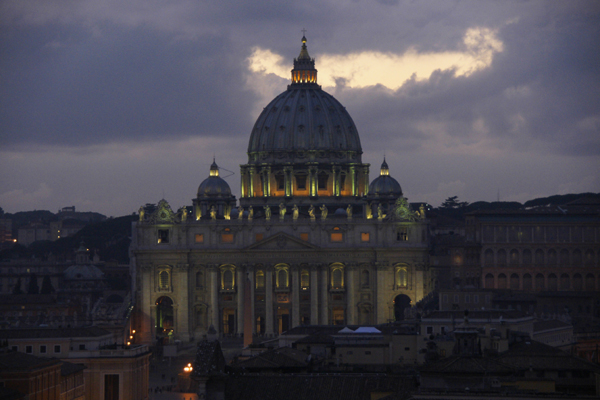

Because the world under thy conduct has risen triumphant to the heavens, Constantine the conqueror has built this temple in thy honor. This inscription stood in letters of gold over the triumphal arch in the ancient Vatican Basilica. Never did the Roman genius frame a more magnificent utterance in so few words; never did the greatness of St. Peter appear to such advantage on the seven hills. In 1506 the great arch, that had looked down upon 12 centuries of prostrate pilgrims, fell from old age, and the beautiful inscription perished. But Michelangelo's lofty dome points out to the city and the world the spot where sleeps the Galilaean fisherman, the Successor of the Caesars, the Vicar of Christ, the ruler of the destinies of Rome.
The second glory of the eternal city is the tomb of St. Paul on the Ostian Way. Unlike that of St. Peter, which lies deep down in the Vatican crypt, this tomb is raised to the level of the floor by massive masonry, on which rests the great sarcophagus. This circumstance was ascertained in 1841, when the papal altar was reconstructed. It was evidently to obviate the consequences of inundations from the Tiber that the sarcophagus had thus been raised above the place where Lucina had first laid it. The pilgrim certainly finds nothing to blame in this arrangement when, on looking through the small opening in the center of the altar, his respectful glance falls upon the marble of the tomb, and he reads these imposing words traced in large characters of Constantine's period: To Paul the Apostle and Martyr.
Thus Christian Rome is protected on the north and south by these two citadels. Let us enter into the sentiments of our fathers, when they said of this privileged city: "Peter the doorkeeper sets his holy dwelling at the entrance: who can deny that this city is like Heaven? At the other extremity, Paul from his temple guards the walls; Rome lies between the two: here then God dwelleth" (Inscription on the gate of Rome which was called in the 6th century 'the gate of St. Peter'.)
The present feast therefore deserves to be more than a local solemnity; its extension to the Universal Church is a subject for the world's gratitude. Thanks to this Feast we can all make together in spirit today the pilgrimage, which our ancestors performed with such fatigue and danger, yet never thought they purchased at too high a price its holy joys and blessings. "Heavenly mountains, glittering heights of the new Sion! There are the gates of our true country, the two lights of the immense world. There Paul's voice is heard like thunder; there Peter withholds or hurls the bolt. The former opens the hearts of men, the latter opens Heaven. Peter is the foundation-stone, Paul the architect of the temple where stands the altar by which God is propitiated. Both together from a single fountain, which pours out its healing and refreshing waters" (Venantius Fortunatus).
In the following lessons the Roman Church gives us Her traditions concerning the two basilicas whose dedication feast we are celebrating:
Among the holy places venerated of old by the Christians, those were the most honored and most visited in which the bodies of the Saints are preserved, or some relic or memorial of the martyrs. Chief among these holy places has ever been that part of the Vatican hill which was called the Confession of St. Peter. Christians from all parts of the world flocked there, as to the rock of the Faith and foundation of the Church, and honored with the greatest reverence and piety the spot hallowed by the sepulcher of the Prince of the Apostles.
On the octave day of his baptism, the Emperor Constantine the Great came here; and taking off his diadem, he prostrated on the ground with many tears. Then taking a hoe and mattock he broke up the earth, of which twelve basketfuls were taken away in honor of the Twelve Apostles; and on the site thus marked out he built the Basilica of the Prince of the Apostles. Pope St. Sylvester dedicated it on the 14th of the Calends of December (November 18th), just as he had consecrated the Lateran Church on the 5th of the Ides of November (November 9th). He erected in it a stone altar which he anointed with chrism, and decreed that thenceforward all altars should be made of stone (or contain an "altar stone.") The same Blessed Sylvester dedicated the Basilica of St. Paul the Apostle on the Ostian Way, also magnificently built by the Emperor Constantine, who enriched both Basilicas with many estates and rich gifts and ornaments.
The Vatican Basilica, however, began to decay through age; and was rebuilt from its foundations on a more extensive and magnificent scale, through the piety of several Pontiffs. It was solemnly dedicated by Urban VIII on this same day in the year 1626. In the year 1823 the Ostian Basilica burned to the ground; but the ruins were repaired and it was rebuilt more splendidly than before, through the unwearied exertions of four Popes. Pius IX, seizing the auspicious occasion when his definition of the Dogma of the Immaculate Conception of the Blessed Virgin Mary had drawn an immense number of Cardinals and Bishops even from distant parts of the Catholic world to Rome, solemnly dedicated this Basilica on the 10th of December, 1854, assisted and surrounded by this noble gathering of prelates; and he decreed that the anniversary commemoration should be celebrated on this day.
Contact us: smr@salvemariaregina.info
Visit also: www.marienfried.com